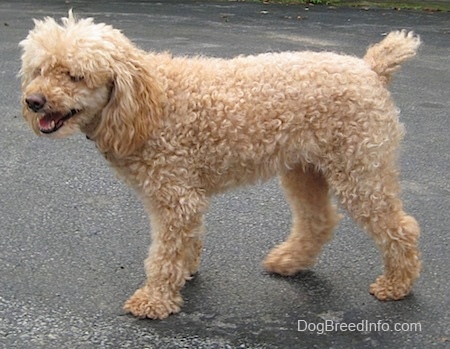
Luca the male apricot colored Mini Poodle at 5 years old
MIN-ee-uh-cher POO-duhl
Miniature Poodle in other languages
French: Carniche Moyen
Italian: Barboncino Miniatura
When groomed to show dog standards the Miniature Poodle’s body is meant to give off a square appearance. It is approximately the same length as the height at the withers. The skull is moderately rounded with a slight but definite stop. It has a long, straight muzzle. The dark, oval-shaped eyes are set somewhat far apart and are black or brown. The ears hang close to the head and are long and flat. Both the front and back legs are in proportion with the size of the dog. The topline is level. The tail is set and carried high. It is sometimes docked to half its length or less to make the dog look more balanced. Note: Docking tails is illegal in most European countries. Dewclaws may be removed. The oval-shaped feet are rather small and the toes are arched. The coat is either curly or corded. It comes in all solid colors including black, blue, silver, gray, cream, apricot, red, white, brown or café au lait. While it does not make the written show standard, some breeders are breeding parti-colored Poodles. See grooming for different types of Poodle clips.
The Miniature Poodle is an intelligent, joyful companion dog. It can be trained to a high degree and is very willing and happy to please its handler. Comical and clever, it is often used as a circus dog. The more intelligent a dog is, the more it needs its mind occupied. This breed cannot live outside in a kennel. It needs to be part of the family. It can be high-strung if not given the proper type and amount of exercise. Do not allow this dog to develop Small Dog Syndrome, where the dog is led to believe it is alpha over humans. It can cause the dog to become sensitive and nervous, and not very trustworthy with children and possibly strangers, along with many other behavior issues. Socialize your dog well. This is a very good watchdog for its size, seldom becoming aggressive. Dogs may start to bark a lot without proper human to canine communication, rules to follow and limits to what they are allowed to do. Poodles are friendly with other dogs and non-canine pets. Be sure you are this dog’s firm pack leader to avoid any unwanted behavior problems.
Height: 11 - 15 inches (28 - 38 cm)
Weight: 15 - 17 pounds (7 - 8 kg)
The sizes of the official AKC-recognized Poodle breeds are determined by height, not by weight. The Miniature Poodle must be over 10 inches and 15 inches or less at the highest point of the shoulder. Any Poodle which is over 15 inches or is less than 10 inches at the highest point of the shoulder cannot compete in the AKC show ring as a Miniature Poodle.
Prone to cataracts, progressive retinal atrophy (PRA) which may cause blindness, IMHA (Immune Mediated Hemolytic Anemia), heart disease, diabetes, epilepsy, runny eyes, ear infections and skin allergies. Brown Poodles tend to become prematurely gray.
The Miniature Poodle is good for apartment life. It will be calm indoors if it receives enough exercise. It will do okay without a yard.
Miniature Poodles need a daily walk. While out on the walk make sure the dog heels beside or behind the person holding the lead, never in front, as instinct tells a dog the leader leads the way, and that leader needs to be the human. As with all breeds, play will not fulfill their primal instinct to walk. Dogs that do not get to go on daily walks are more likely to display behavior problems. They will also enjoy a good romp in a safe, open area off lead, such as a large, fenced-in yard. They adore water and love sessions of play. They are a very versatile breed with a hunting and retrieving beginning, although they excel in any performance event you offer them, including agility, obedience, rally and conformation showing, and often one will leave one ring and go directly to another to compete again. Since they love water they are great dock diving dogs and love water retrieving.
About 12-15 years
About 1 to 10 puppies, average of 5
Extensive grooming is needed if the dog is to be shown. Poodles must be bathed regularly and clipped every six to eight weeks. Clean and check the ears frequently for wax or mites or infection and pull out hairs growing inside the ear canal. The teeth need regular scaling. Since the coat does not shed it needs to be clipped. There are several different types of Poodle clips. The most common for pet owners is an easy-care clip called a "pet clip," "puppy clip" or "lamb clip," where the coat is cut short all over the body. Popular show clips are the English saddle and the Continental clip where the rear half of the body is shaved, bracelets are left around the ankles, and pom-poms are left on the tails and hips. The AKC standard allows for a dog under a year old to be shown in a show-style puppy clip which has special requirements such as a pom-pom on the end of the tail. Other clip styles are the modified continental clip, town and country clip, kennel or utility clip, summer clip, and the Miami of bikini clip. Poodles shed little to no hair and are good for allergy sufferers.
The Poodle has been known throughout Western Europe for at least 400 years and is depicted in 15th century paintings and in bas-reliefs from the 1st century. The subject is controversial of where the dog was officially developed and no one really knows the breed’s true country of origin. France has taken a claim on the origin, but the AKC gives the honor to Germany, where they say it was used as a water retrieval dog. Other claims have been Denmark, or the ancient Piedmont. What is certain is that the dog was a descendant of the now extinct French Water Dog, the Barbet and possibly the Hungarian Water Hound. The name "Poodle" most likely came out of the German word "Pudel," which means "one who plays in water." The "Poodle clip" was designed by hunters to help the dogs swim more efficiently. They would leave air on the leg joints to protect them from extreme cold and sharp reeds. Hunters in Germany and France used the Poodle as a gundog and as a retriever of waterfowl and to sniff out truffles lying underground in the woods. The French started using the breed as a circus performer because of the dog's high intelligence and trainability. The breed became very popular in France, which led to the common name "French Poodle," but the French people actually called the breed the "Caniche," meaning "duck dog.” The Toy and Miniature Poodle varieties were bred down from larger dogs, today known as Standard Poodles. In the 18th century, smaller Poodles became popular with royal people. The three official sizes are the Toy, Miniature and Standard Poodle. They are considered one breed and are judged by the same written standard but with different size requirements. Breeders are also breeding an in-between size called a Klein Poodle (Moyen Poodle) and a smaller Teacup Poodle. Some of the Poodle's talents include: retrieving, agility, watchdog, competitive obedience and performing tricks.
Gun Dog, AKC Non-Sporting
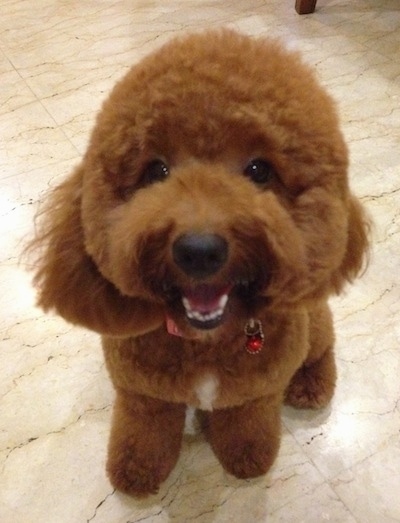
Leia the Miniature Poodle at 2 years old—"Leia is sweet, obedient, and extremely friendly. She can be a dog you take on a long hike or a total couch potato. She reads my moods easily and knows to settle down when I want her to. She loves being with people, but she's not too clingy. She does almost everything with us, as long as she's doing something with my family and I, it's her favorite thing to do. I do watch Cesar Millan, and I agree with a lot of his philosophies and apply them with my dog, and I'm quite sure it has helped to mould her into the amazing canine companion she is today. Although I must note she didn't have many behavioral issues in the first place, as she is naturally calm and submissive, so I didn't have to do too much. But it has definitely helped establish my place as pack leader in her eyes."
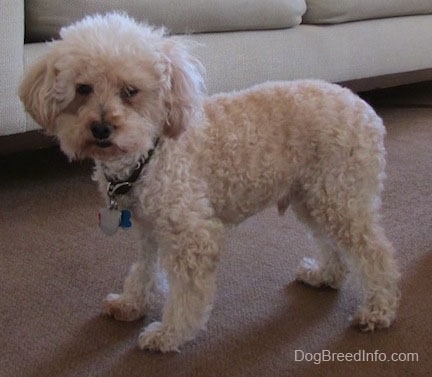
Sammy the Miniature Poodle at 11 years old

Murphy the Miniature Poodle at 1 year old
Ethan the Mini Poodle
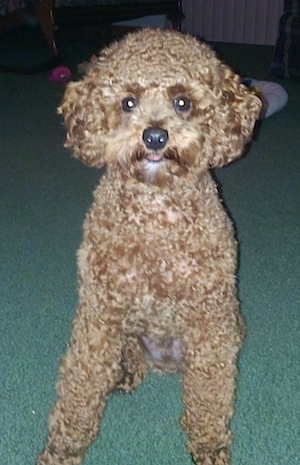
"This is my dog Rudy. He is extremely smart. When he is playing he runs behind you and he screams until you stop so he can get in front of you. He also runs to the door and hits his harness while screaming, barking, and crying when you ask him if he wants to walk or go bye-bye in the car. He knows many tricks too—he can sit, beg (sits and looks like a prairie dog), spin, speak, lie down, roll over, stand on 2 legs, dance, and come on command. Another funny thing he does is roll and rub against everything and basically go crazy whenever I spray any perfume. He is also very ticklish (which he shows by 'talking' whenever you touch his hips). He is a little on the smaller side for a Miniature, being 10 pounds and 12 inches tall to the shoulder. He is such a pretty dark red color, too. Everybody always stops and asks what breed he is and if reds are rare. He is the perfect dog."
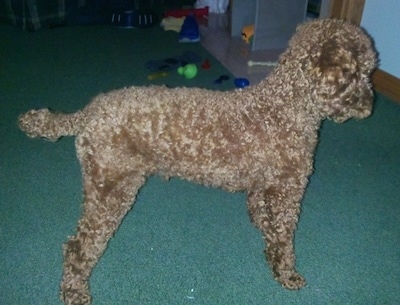
Rudy the Miniature Poodle at 1 year old
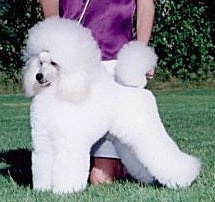
Can. Ch. Rosebell's Exceptionn (call name: Nick), photo courtesy of Rosebell Kennels
Peanut the Mini Poodle puppy at 9 weeks old
Peanut the Mini Poodle puppy at 3 months old after his first haircut playing with his stuffed rabbit toy
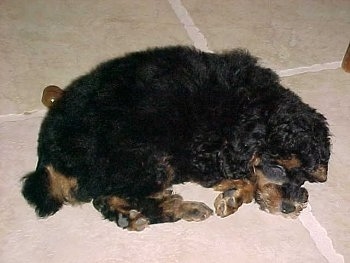
Charlie a phantom Mini Poodle as a puppy at 8 weeks old sleeping on the floor
Official AKC-Recognized Poodles
Non-AKC Poodle Types